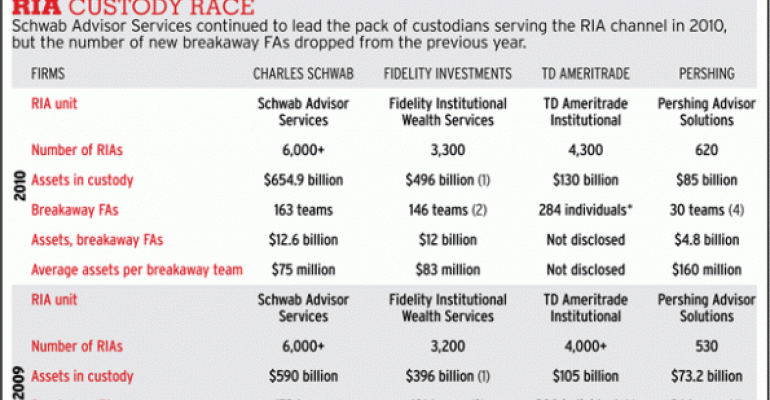Greg Erwin and his team of three advisors had worked at Smith Barney and its predecessor firms for almost their entire careers. But in early 2008, they began to talk about making a move. Then the market fell off a cliff, the economy tanked, Bear Stearns and Lehman Brothers toppled and Morgan Stanley and Smith Barney jumped into a joint venture together. And that’s when Erwin and his team decided it was time to establish an independent RIA firm.
“Over time, I think that the cumulative number of mergers started to kind of wear on us a little bit,” he said. (They started with Primerica, which bought Shearson Lehman and merged it with Smith Barney in 1993. At the end of 1993, Smith Barney became a subsidiary of Travelers Group, formed by the acquisition of The Travelers by Primerica. In 1997, the unit was merged with Salomon Inc. to form Salomon Smith Barney Holdings, which later became Citigroup.)
It took the team another year to make the transition, but in October 2010 their new RIA Sapient Private Wealth Management opened its doors for business with over $500 million in client assets.
Mentioned In This Article
 |
While the number of breakaway brokers starting or joining RIAs affiliated with Fidelity slowed somewhat last year from 2009, the size of those breakaways making the move to Fidelity is growing, the firm says. In 2010, the custodian helped 146 individual brokers and teams with $12 billion in assets break away, compared to 191 breakaways in 2009. But the average assets per breakaway were about $83 million last year, it says, a 50 percent boost over 2009. It’s not a new trend for the No. 2 RIA custodian. Fidelity has been seeing larger teams joining for many months now.
Why the shift to bigger breakaways? Michael Durbin, president of Fidelity Institutional Wealth Services says that in 2009, the industry was in a crisis phase, and smaller advisors were either asked to leave or chose to leave because they had anxiety over the model or stability of the firm. “That has washed itself through,” he said.
The thing is, breakawy teams converting to RIAs are not getting bigger industrywide. The number of breakaway teams starting or joining RIAs that custodied with Schwab slipped to 163 last year from 172 in 2009, but the size of those teams was about on par with 2009. They had average assets of $75 million last year, just a hair below the previous year's $76 million. Over at Pershing, the number of teams starting their own RIAs actually rose to 30 from 24 the previous year, while assets per team climbed to $160 million from $120 million in 2009. TD Ameritrade did not disclose its breakaway numbers in terms of teams, nor did it disclose total breakaway assets or assets per breakaway team. (See below for a table of RIA and asset numbers.)
Wait And See
Fidelity speculates that the bigger teams breaking away today may have been waiting around for the right market conditions. That was the case for Erwin and his team. “As the situation unfolded, it was inappropriate for us to put clients through that transition in the midst of global economic chaos,” Erwin said.
From early 2008 to late 2009, the bigger, longer-tenured teams were focused on stabilizing their clients and settling their book of business, first and foremost, Durbin said. In addition, as the storms settled and these big firms went through all the transformative changes—the mergers and acquisitions and joint venture activity—some large advisors decided to stick it out and see how things would look after the dust settled, he added. But by 2010, many were ready to jump ship if they didn’t see “a palpable improvement in the state of affairs,” he said.
The larger ones held on longer, perhaps because they had signed lock-in contracts, said Alois Pirker, research director at Aite Group. They gave it a chance, but once the markets got better, they were more willing to take a plunge.
“After the chaos of the financial crisis, many of the smaller advisors took the opportunity to go independent or were shown the door by the big wirehouses,” said Tim Welsh, president of Nexus Strategy of Larkspur, Calif. “The larger teams received retention packages and stayed put, thus skewing the average AUM size of the breakaways.”
Last year, the book size of advisors grew as the markets improved, so this could also be why average assets were up, Pirker said. On average, advisors take 60 percent of their book with them, he said. But very successful advisors at the top end often take their full book—all their clients.
Independent Models
Durbin also points to the innovation around new independent models, such as aggregator and rollup firms, as a draw for larger teams. This includes firms like HighTower, Focus Financial, United Capital and U.S. Capital. These firms are very well capitalized and provide an independent destination so that advisors don’t have to go it alone, Durbin said.
“Larger teams or larger practices are finding ways to make the transition to independence through firms like Focus Financial,” said Erwin. “The bridge-builders are becoming more prolific.”
“Now with the markets returning and the larger teams realizing the many benefits of going independent RIA (own your own firm, open architecture of product and technology selection, fee-based alignment with client interests, building equity in your new firm, escape from the negative headlines of the wirehouses, etc.), the breakaway trend is continuing and will only accelerate as the retention packages become less onerous to pay back,” said Welsh. 


